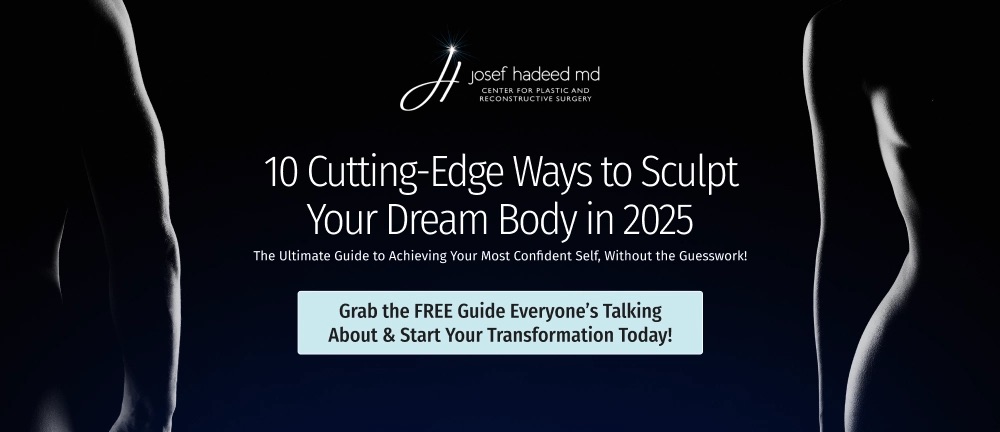The Best Way to Sleep After Tummy Tuck Surgery
Posted August 13, 2025 in Body Procedures by Josef Hadeed, MD

Undergoing tummy tuck surgery can be transformative, as you finally achieve the firmer, flatter midsection you’ve always wanted. Tummy tucks are one of several body contouring plastic surgery procedures designed to help patients achieve their desired aesthetic results by removing excess skin, removing stubborn fat, and tightening the underlying muscles. However, what many people don’t consider when thinking about tummy tuck recovery is the fact that you may need to adjust your sleep position to protect your healing abdomen.
If you are used to sleeping on your side or stomach, adjusting your sleep position in the initial recovery phase after surgery can feel like a challenge. However, the way you sleep plays a significant role in how well—and how quickly— you recover. In this blog, we’ll discuss why sleep and sleeping positions matter after a tummy tuck and share some practical tips to help you rest more comfortably during your recovery.
10 Min Read:
Table of Contents
- Introduction to Sleeping After a Tummy Tuck
- Why Sleep Position Is Important During Tummy Tuck Recovery
- Tips for Managing Pain and Sleeping More Comfortably
- Incision Site Protection While Sleeping
- How Long Do I Have to Sleep on My Back After a Tummy Tuck?
- When Can I Sleep on My Side After a Tummy Tuck?
- How to Transition Safely From Reclined to Side Sleeping After Tummy Tuck Surgery
- When Can I Sleep on My Stomach After a Tummy Tuck?
- The Importance of Sleep During Tummy Tuck Recovery
- How to Sleep More Comfortably After Tummy Tuck Surgery
- Explore Your Tummy Tuck Options in Beverly Hills
Introduction to Sleeping After a Tummy Tuck
Sleeping is one of the most important factors after an abdominoplasty to ensure a smooth recovery process and allow your body to heal properly. Your sleeping position can significantly affect both your comfort and results during the initial recovery phase. The best way to sleep after a tummy tuck is to sleep on your back. Proper sleep positioning—specifically, keeping your upper body elevated and lying on your back—helps reduce swelling, promotes healthy circulation, and minimizes pressure on your abdominal area. This position supports optimal healing and can make sleeping much more comfortable.
Your board-certified plastic surgeon will give you specific guidance on how to sleep and manage discomfort after surgery, helping you support your recovery and the healing process. Getting quality restful sleep and following your surgeon’s instructions are key to a smooth recovery after your surgical procedure and feeling better sooner.
Knowing what your tummy tuck involves—and how your body will respond afterward—can make a big difference. Understanding how to position yourself while sleeping and how to manage postoperative discomfort allows you to plan ahead, stay comfortable throughout the recovery process, and get the best possible outcome from your body contouring procedure.
Why Sleep Position Is Important During Tummy Tuck Recovery
After a tummy tuck, your abdominal skin and underlying muscles need time to heal. Proper sleep position supports the body’s healing process and protects the surgical area. During this process, stress or tension on the incision site can interfere with healing, cause unnecessary discomfort, and even impact your final results.
You should not sleep flat on your stomach immediately after a tummy tuck. Even lying flat on your back can be problematic. The wrong sleeping position after surgery can impede proper healing and lead to a number of issues, such as:
- Putting pressure on your incision or internal sutures
- Causing more swelling and discomfort
- Disrupting circulation and fluid drainage
- Risking wound separation or longer healing times
Following your surgeon’s sleep position guidelines can make a big difference in how smoothly and comfortably you recover. Sleeping in the right position after surgery helps take pressure off your incision, easing strain on the area and promoting a quicker recovery after a tummy tuck.
Tips for Managing Pain and Sleeping More Comfortably
Getting restful sleep after a tummy tuck can be difficult if you’re experiencing pain. That’s why it’s important to stick to your surgeon’s pain management plan.
Prioritizing pain management will help you get the restorative sleep your body needs for a comfortable recovery after your tummy tuck procedure. Here are some simple strategies that can help improve your comfort and make it easier to sleep comfortably:
- Create a calm and quiet sleep environment. Make your bedroom a peaceful space to help you relax and sleep more comfortably.
- Add calming routines before bed. Relaxation techniques—such as deep breathing, meditation, and diffusing essential oils—can help your body wind down.
- Sleep with your upper body slightly elevated. Using a firm, supportive pillow beneath your upper body can help alleviate pressure on your abdominal area, allowing you to find a more comfortable sleep position.
If you’re having trouble sleeping or the pain isn’t improving, don’t hesitate to contact your surgeon so they can adjust your recovery plan.
Incision Site Protection While Sleeping
Protecting your incision site while sleeping is critical after abdominooplasty surgery. Place pillows around your body to support a stable sleeping position and reduce the risk of accidentally rolling onto your incision site.
Wearing compression garments as instructed by your surgeon is just as important—it helps protect your healing tissues and reinforces your new shape as your body recovers.
Keeping your sleep area clean and free from potential irritants is another important step in minimizing the risk of infection. Always follow your surgeon’s postoperative instructions regarding incision care and use of compression garments to ensure your recovery process stays on track and your surgical site heals properly.
How Long Do I Have to Sleep on My Back After a Tummy Tuck?
Like most patients, you’ll need to sleep on your back in a specially adjusted, modified position for at least 2 to 4 weeks after your abdominoplasty surgery. By maintaining a reclined position while staying slightly elevated and keeping a slight bend in your hips or torso, you can keep tension off your incision and reduce the risk of fluid buildup or damage to your tightened and sutured abdominal muscles.
Here are some practical tips for sleeping during the initial tummy tuck recovery period:
- Use a recliner or build a supportive setup in bed. Many patients find sleeping in a recliner the easiest way to stay upright and stable. If you don’t have one, you can create a similar setup in bed by stacking multiple pillows or a wedge pillow to prop up your upper body.
- Keep yourself at a 30 to 45-degree angle. This slight incline helps reduce swelling and keeps tension off your incision. Lying flat can put pressure on your healing tissues, which is why staying slightly upright makes a real difference.
- Place a pillow under your knees. Keeping your knees in a slightly bent position helps take even more pressure off your core. It also keeps you from unintentionally stretching out flat while you sleep.
- Add extra pillows at your sides to keep you in place. Surrounding yourself with pillows on each side of you helps prevent you from rolling over in the middle of the night. It’s a simple trick, but it works, especially during the first week when your body is adjusting to your new sleep setup.
Dr. Hadeed will go over a specific timeline with you, but in general, sleeping on your back during the first few weeks after your tummy tuck is non-negotiable. Most patients will need to maintain this modified position for several weeks to ensure optimal healing and recovery.
When Can I Sleep on My Side After a Tummy Tuck?
Adjusting to new sleeping positions is an important part of the tummy tuck recovery process. If you’re a side sleeper, you’re probably eager to return to your usual sleep position. The timeline for when you can resume sleeping on your side varies for each patient, as sleeping varies based on individual healing and medical advice. You can likely begin to slowly transition to side sleeping around week 4 to 6 after your tummy tuck, depending on how your body is healing and Dr. Hadeed’s recommendations.
How to Transition Safely From Reclined to Side Sleeping After Tummy Tuck Surgery
You’ll want to wait until your surgeon gives you the green light before returning to your usual side-sleeping position. When that time comes, take it slowly—there’s no need to rush it.
- Try easing into the new position by slightly turning your body instead of going fully on your side right away. A body pillow or wedge pillow behind your back can help keep you stable, and placing one between your knees can help alleviate pressure on your stomach.
- Adding a few extra pillows for support can make a big difference in helping you stay comfortable throughout the night.
- Avoid curling up too tightly. Maintain a slightly bent position by keeping your knees slightly bent, but don’t compress your core.
- Alternate sides if you’re comfortable, but always return to back sleeping if any soreness returns.
Once you feel comfortable, start with short periods of side sleeping and notice how your body feels. Pay close attention to your body’s signals—if you notice any pulling, soreness, or swelling, return to reclined back sleeping for a little longer. There’s no rush, and overdoing it can set back your recovery.
When Can I Sleep on My Stomach After a Tummy Tuck?
Sleeping on your stomach post tummy tuck surgery is a definite no-no during the first few months. Sleeping on your stomach too soon can put undue stress on your newly tightened abdominal muscles, which need time to heal properly. Most surgeons recommend waiting at least 8 to 12 weeks—and sometimes even longer—before returning to this position. Why? Sleeping on your stomach too early after a tummy tuck can:
- Put direct pressure on your incision
- Disrupt the internal healing process of your muscle repair
- Increase swelling and the risk of developing seromas
- Potentially flatten or distort your results
If you’re naturally a stomach sleeper, it may be frustrating to have to adjust, but the long-term payoff is worth the temporary inconvenience. You should only return to sleeping on your stomach once your surgeon confirms your newly repaired muscles have healed sufficiently. Once Dr. Hadeed gives the go-ahead to return to your regular sleeping position on your stomach, ease back in slowly. Or, even better, consider transitioning to side sleeping first and then eventually to your stomach, allowing your body more time to adjust.
The Importance of Sleep During Tummy Tuck Recovery
Quality sleep is critical for healing after surgery. Sleep is when the body heals most effectively, making it an important part of your recovery. Your body doesn’t know the difference between a surgical procedure and an injury or other trauma, so you have to be gentle with yourself as you heal. Getting quality, restful sleep helps your body:
- Repair damaged tissues
- Reduce inflammation and swelling
- Balance hormones that aid in cell regeneration
- Boost your immune function to fight infection
Prioritizing sleep quality is key to a smoother recovery after tummy tuck surgery. A lack of sleep can result in a longer recovery, increased pain, and emotional stress. That’s why it’s important to create a sleep environment that helps your recovery.
How to Sleep More Comfortably After Tummy Tuck Surgery
Sleep can be a little tricky post tummy tuck surgery, but there are ways to make it more comfortable.
- Sleep in a recliner or adjustable bed. Keeping your upper body elevated and your knees slightly bent can help alleviate pressure on your abdomen, making it easier to relax.
- Use multiple pillows to your advantage. Tuck them behind your back, under your knees, or even hug a body pillow to help stay in a supported, relaxed position throughout the night.
- Wear your compression garment while sleeping to support proper healing and help in reducing swelling, keeping your new contours supported.
- Make sure your bedroom stays cool and comfortable, since getting too warm can lead to irritation and swelling and make it harder to sleep.
- Take prescription pain medication as instructed to stay ahead of any discomfort and prevent it from waking you up at night.
- Skip the caffeine and limit screen time so your body can wind down more easily for restful, uninterrupted sleep.
Most importantly, remember that it’s okay to ask for help. Especially early on, movements that engage your core—like sitting up—can cause unnecessary strain to your incision and be extremely uncomfortable. Ask a partner or caregiver for support when standing up, or roll to your side and push yourself up with your arms to help alleviate discomfort when getting out of bed. These strategies are important for protecting the surgical area and supporting healing during recovery.
Explore Your Tummy Tuck Options in Beverly Hills
Sleep might not be the first thing that comes to mind when you’re preparing for tummy tuck surgery, but sleep is a vital part of your recovery. Giving your body the rest it needs will help preserve your results and get you back to feeling—and looking—your best. To learn more about the benefits of tummy tuck surgery, schedule an appointment with Dr. Josef Hadeed. Dr. Hadeed is a board-certified plastic surgeon in Beverly Hills with extensive experience and expert surgical technique performing body contouring surgical procedures, including full tummy tucks and mini tummy tucks.
Schedule your personal consultation with Dr. Hadeed today by calling (310) 970-2940 or requesting an appointment online.

